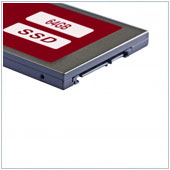
The hard disk drive (HDD) has been an essential part of computers more or less since their inception.
While they have gotten smaller and increased in capacity, they are quickly reaching a point where they won’t be able to go any faster, hold any more or last any longer. There is a replacement already making a splash with some great advantages, the solid-state drive (SSD).
You’ve likely heard of SSDs – drives that have no moving parts – and you may have even looked at the price of them. Yes, they are more expensive when compared with the aging HDD platform, SSDs however have a number of benefits over their cheaper cousins.
Here’s five benefits of using SSDs in your company:
- They’re speedy – Put an SSD into a computer or laptop and you’ll notice it screams. On some laptops, like the Google Chromebook, startup time can be as quick as eight seconds. This gets you into your desktop and to your work faster. While it’s only seconds at each startup, it can add up to extra hours across the whole company. Access speed is also important, as traditional HDDs can access data at a rate of about 140 MB/s, while SSDs can access data at over 600 MB/s. This means your computer runs faster.
- They’re tough – There are no moving parts to most SSDs, so they are less likely to break. That’s why they have been used by militaries, the aeronautical industry and the medical industry for years. Another advantage of not having moving parts is that the SSD will function in a greater temperature range, which is good news for businesses operating extreme climates, or even in the confines of hot server rooms.
- They can help increase battery life – The power draw of the SSD is considerably lower than HDDs, which means battery life is extended. Some laptops with SSD-only drives can last 8-10 hours, compare this to six hours, (if you’re lucky), on laptops with HDD. When installed in computers, there is a cost savings in energy bills too and while this might not amount to huge savings these can add up over time.
- They last longer – HDD’s moving parts mean that they eventually wear out, or crash. If this happens, the information stored on the drive will likely be inaccessible. SSDs are predicted to last far longer, which means your data is safer on these drives in the long-run.
- They can be safer – Some SSDs utilize a memory system similar to flash drives. With an OS that can be configured to this type of memory, users can install these onto the drive, lock it and then use the cloud for media storage. Because the SSD can be locked, each time the OS is booted, it’s booted into the original installed state, so malware that attacks the OS is rendered useless as all you have to do is revert the OS to it’s original installed state i.e., restart your computer.
While SSDs have been around for nearly three decades, they are just now starting to make inroads with personal computers, and even business solutions for that matter. The biggest reason for the slow adoption is the price. On average, SSDs cost USD$0.65 for 1 GB while HDDs cost USD$0.05 to USD$0.10 per GB. This may seem like a big cost difference but the price in SSDs is dropping rapidly, while the price for HDDs is largely staying the same. If you’re interested in learning more about SSDs and how they can fit into your company’s IT, please contact us.







 by
by